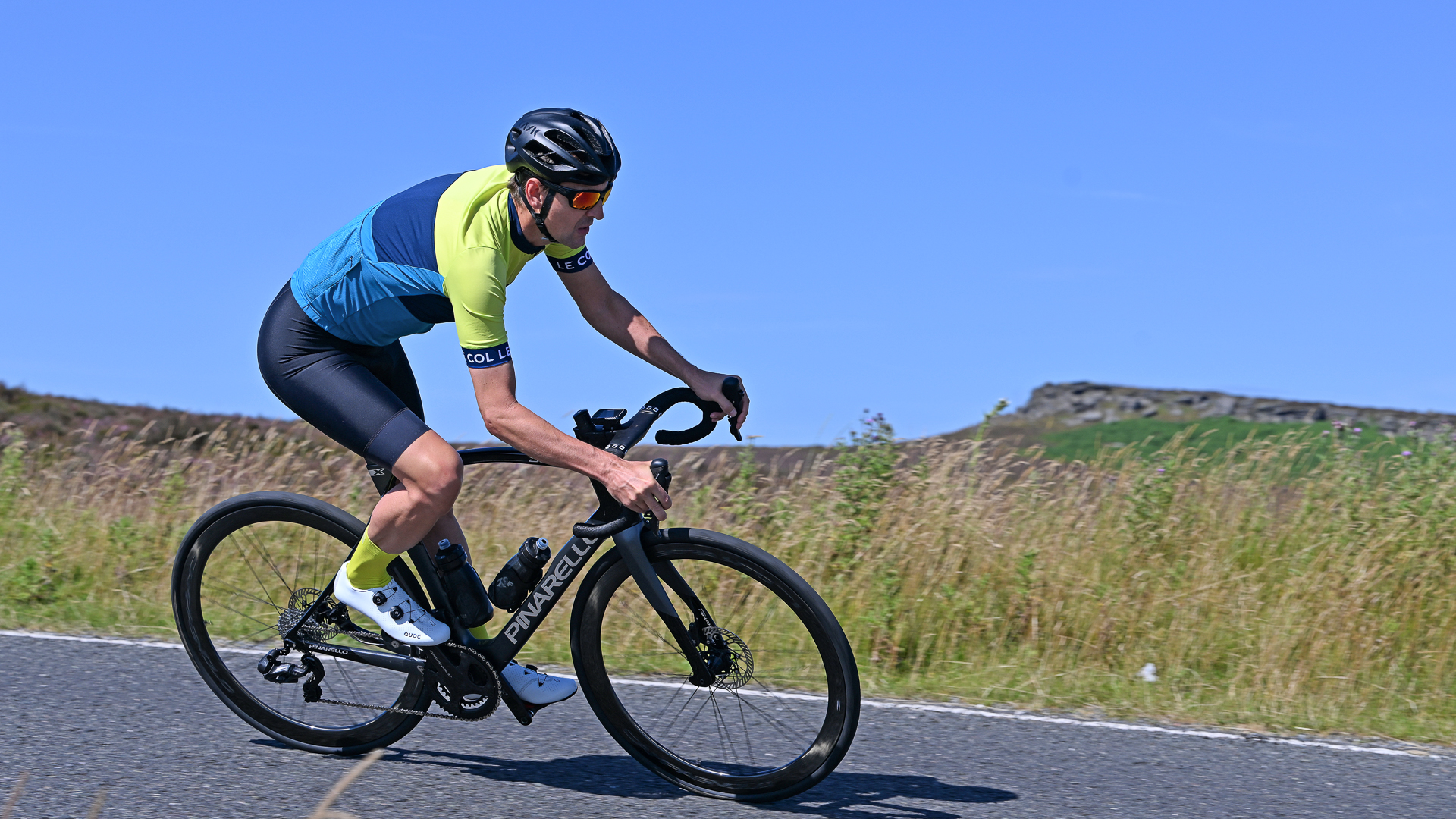
Curiouser and curiouser, as Alice might have said were she inclined to comment on the latest Pinarello road bike. I started thinking I knew what to expect, but the Dogma X wrongfooted.
Pinarello’s Dogma is a very familiar sight to anyone who watches pro bike racing, as it has achieved phenomenal success over its various iterations as Team Sky and Ineos Grenadiers’ weapon of choice. The Dogma X shares many technology and design cues with the newest Dogma F but promises greater comfort and rideability for those more familiar with their chiropractor than their soigneur. Furthermore, Pinarello says that this has been achieved with very little compromise in terms of performance, meaning that, on paper at least, this is probably the Dogma that most of us should be riding if we are honest with ourselves about our abilities and aspirations. A more accessible Dogma it isn’t though, at least not in financial terms, as the range currently consists of just 3 models; Shimano Dura-Ace, SRAM Red and Campagnolo Super Record WRL. Prices start at £13,300. Gulp.
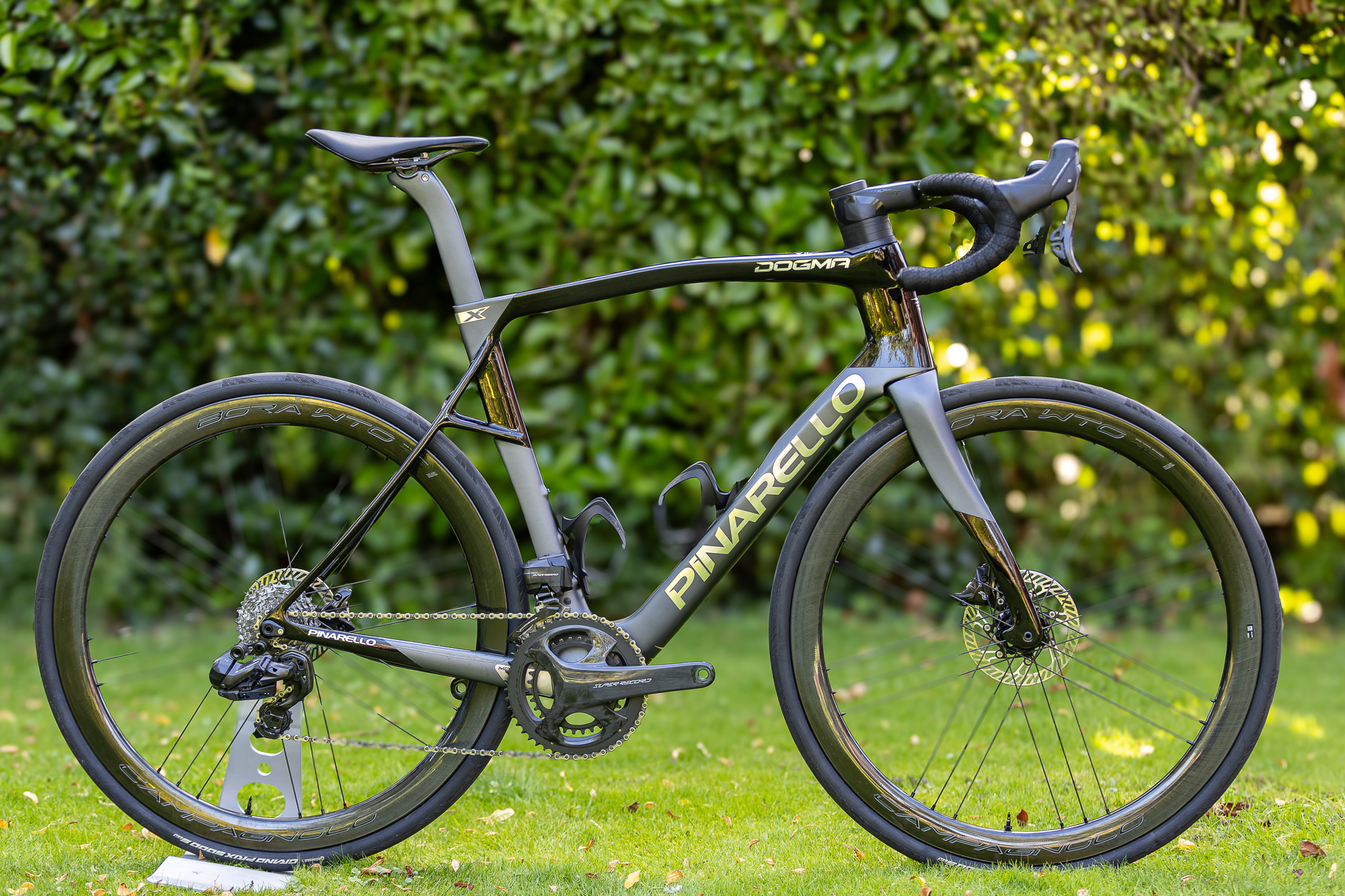
Before riding the bike, I’d read what Pinarello had to say about it - taller stack, more compliance, bigger tyres, slacker geometry - and had some pre-conceived ideas about what to expect, but the more I rode it the more puzzled I became. Indeed, when Joe Baker attended the Dogma X’s launch last year, even Pinarello seemed to be giving slightly mixed messages with Pinarello's Chief of Operations, Maurizio Bellin suggesting it could be an all-road bike whilst the official line was that the bike’s raisin d’etre is efficiency and comfort for all-day riding. They then went and included gravel sections in the test route to confuse things further.
Construction
Dogmas have never been top of any weight-weenies wishlist, a fact that has not troubled the many riders who have ridden them to victory, and I expected its comfier cousin to be fairly portly, but it weighed in at under than 7.5kg (without pedals) in a size 56, not too far off some WorldTour bikes (and less than some…). This is partly due to the hi-spec components and partly due to the sub 1,000g frame - impressive for a disc brake endurance bike with 32mm tyres. The frame uses the same Toray 1100K carbon weave found on the Dogma F, and Pinarello claims that the X frame and fork together only weigh 100g more than that of the F.
One of the more eye-catching elements of the frame is the X-Stays, which apparently improves lateral stiffness in the rear triangle and helps dissipate vibrations. I’m sure the opportunity to include a nice, large ‘X’ in the frame shape also pleased the designers.
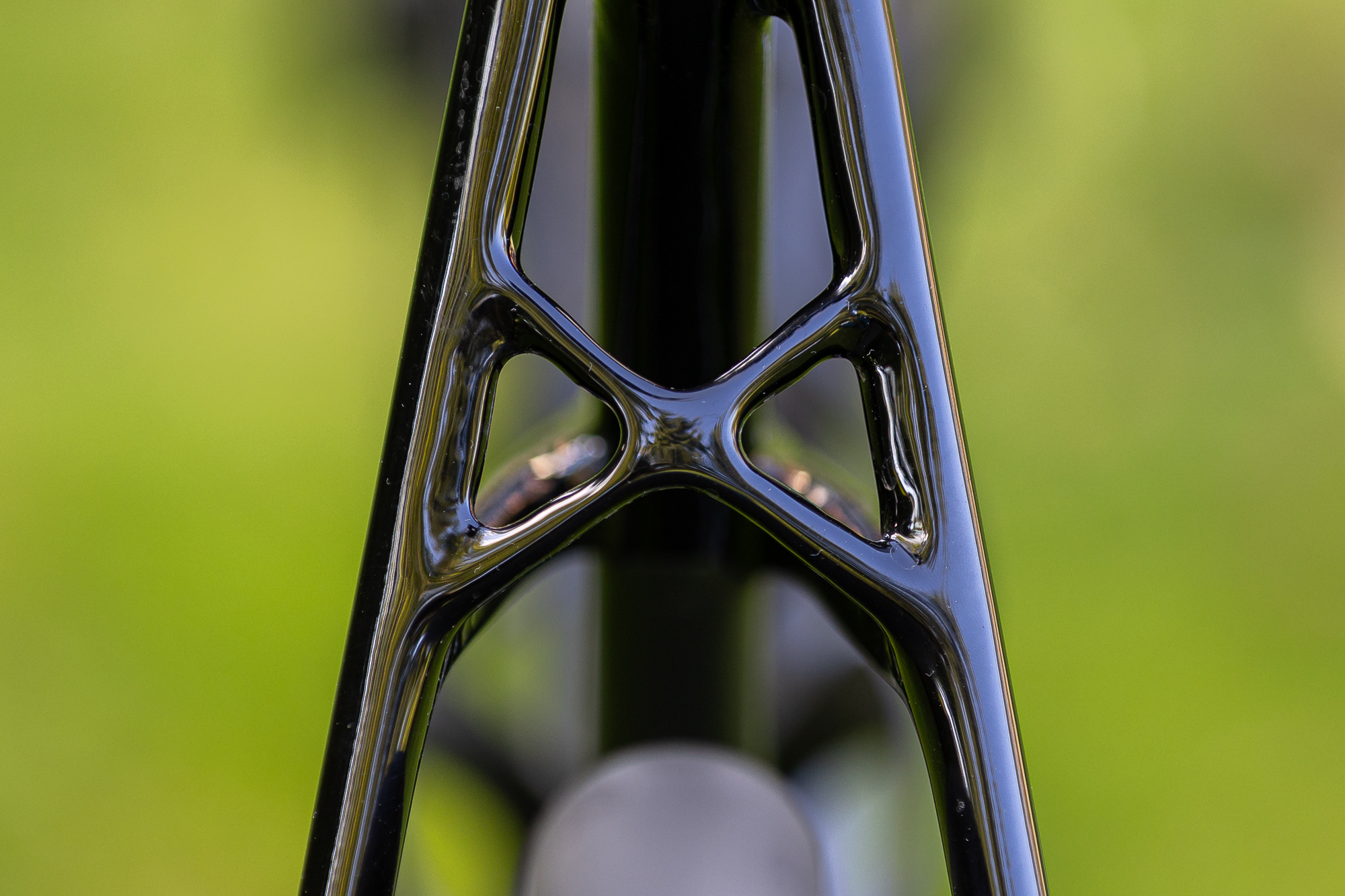
Overall, it's a handsome bike. The front of the frame is quite burly and purposeful looking, with a deep head tube and fork blades, whereas the rear end is very slim and aero. The slightly bowed top tube narrows significantly from front to back too, giving the bike quite a punchy look, especially from the front ¾ angle. There are four colours available, each of which blends matte and gloss paint very smartly.
As with many road bikes these days, clearance for larger tyres has been included, and in fact, the Dogma X was designed around 35mm tyres in conjunction with Pirelli. Unfortunately, production issues for Pirelli meant that the test bike had 32mm Continental GP5000S TRs, although the Pinarello website still lists the 35mm Pirelli P Zero Race TLR tyres on the spec sheet. In contrast, the latest Dogma F can only take 30mm rubber.
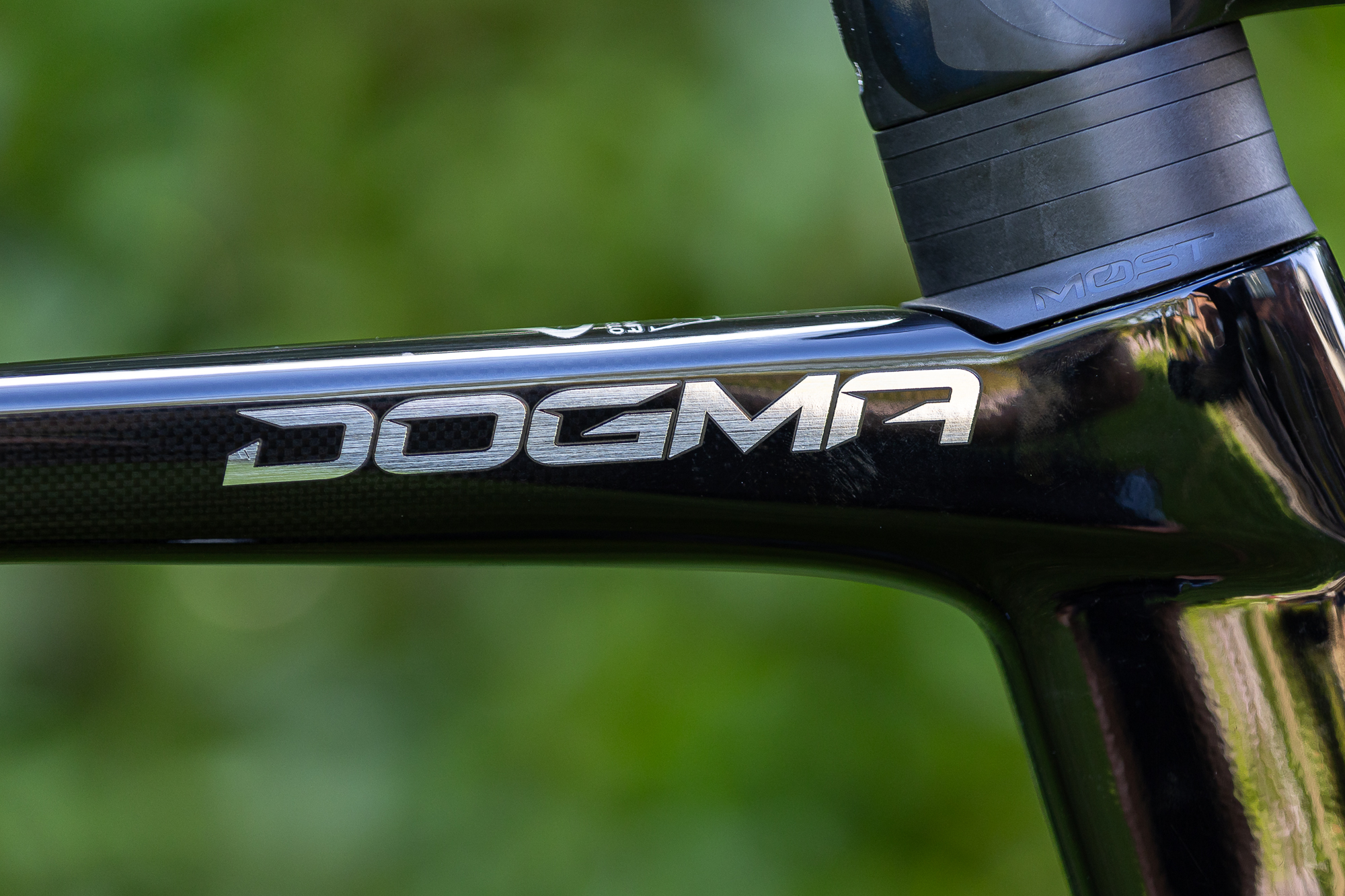
To further differentiate the X from the F, Pinarello says that the endurance bike is 5-10% less stiff around the bottom bracket, which should help to give it a more compliant, less fatiguing ride. There is also a supposed 5% loss in terms of aerodynamics, but as the tests were run with 35mm tyres in place this suggests that the frame, fork and components give little away in terms of drag.
Geometry
No huge surprises here, the Dogma X is slightly slacker with a longer head tube and increased chainstays compared to the F, but other numbers are very similar or identical. Reach is actually fractionally more than the F, and stack a couple of centimetres greater (comparing size 56). The numbers certainly suggest that it is at the sportier end of the endurance bike spectrum and set up racier than most bikes billed as such. Perhaps Pinarello is thinking that the 35mm tyres will do a lot of the heavy lifting in terms of compliance, leaving the frame free to be faster and more efficient.
Components
As you’d hope given the bike’s retail price, the spec list leaves little to be desired, with this model sporting Campagnolo’s new Super Record WRL electronic groupset (without a power meter) and Campagnolo Bora WTO 45 wheels. Super Record WRL will get its own review, so for the sake of this article, suffice it to say that I didn’t get on with it wholeheartedly, but it didn’t detract from the Dogma X experience. As well as being wireless, the other notable element of WRL is that the drivetrain has followed SRAM’s lead and uses a cassette with a 10-tooth sprocket and smaller than usual chainrings too.
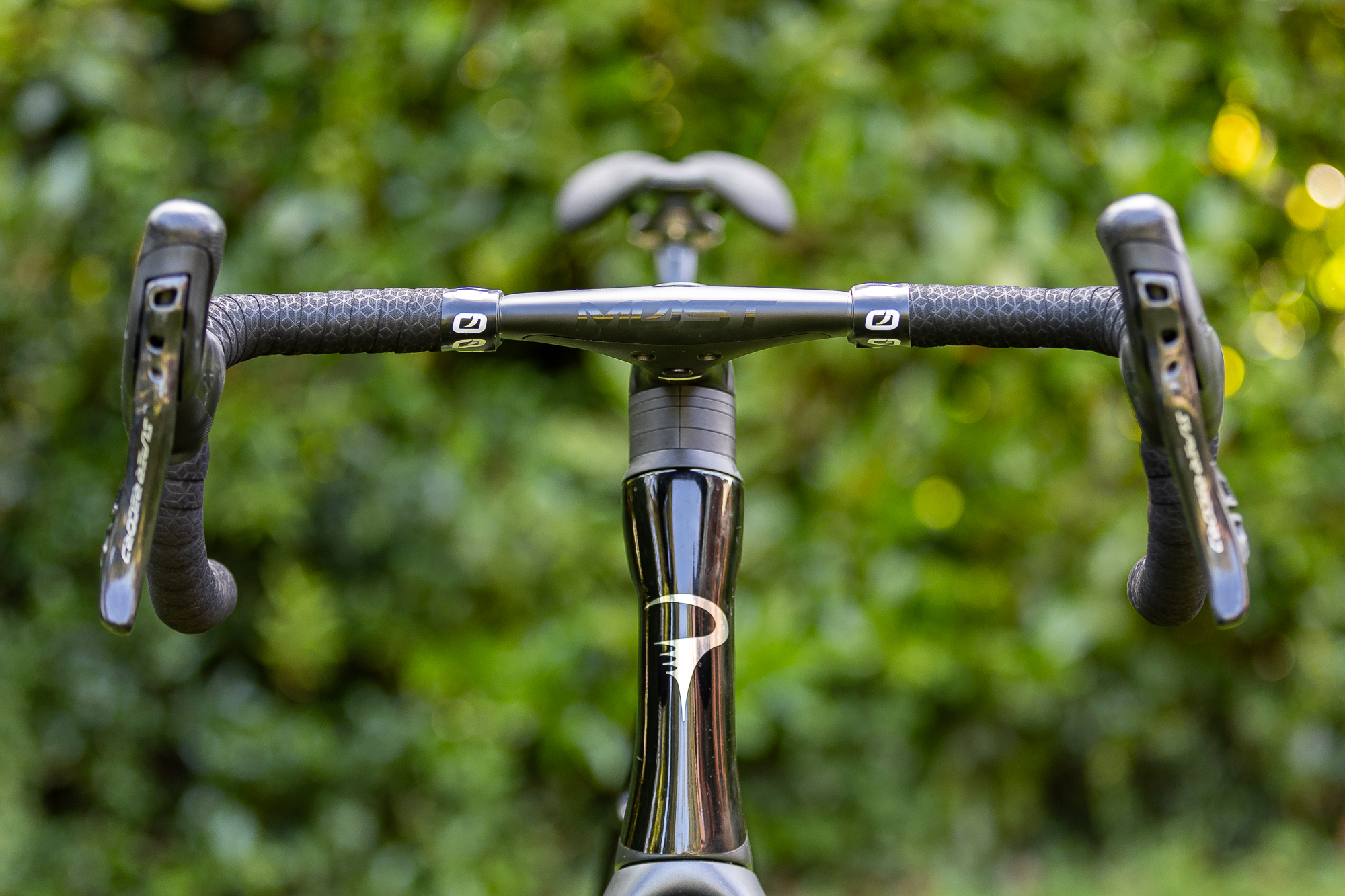
The in-house Most carbon handlebar, seatpost and saddle seem to be straight from the Dogma F, with the handlebar noticeably quite stiff, making the front end less forgiving than I was expecting
The other slightly odd choice here is the distinctive Bora WTO wheels. As good as they are, Campagnolo’s own website states that the “19 mm internal width of the rim enables tyres of 23mm, 25mm and 28mm to be fitted”, and even with the 32mm GP500S TRs the tyre did balloon outside the rim - the listed 35mm Pirellis would bulge out significantly more. Not very aero at all, and not ideal for handling either. The Dura-Ace and SRAM Red versions come with Princeton CarbonWorks Grit 4540 wheels with a better-matched 24mm internal width.
The Ride
This is where things began to get very interesting. Despite not being able to get the front end quite as low as I wanted due to the head tube length, the position felt comfortable and sufficiently racy that I didn’t feel perched up in the wind in the way that some comfort-orientated bikes can. The handlebar is a little wide in the drops, but the combination of bar and shifter shape tucks the hoods inwards slightly for an efficient-feeling position. The Most saddle is a modern, short-nosed design that encourages a forward position and was comfy enough for a few hours but I’d probably swap it out for anything much over 100km personally.
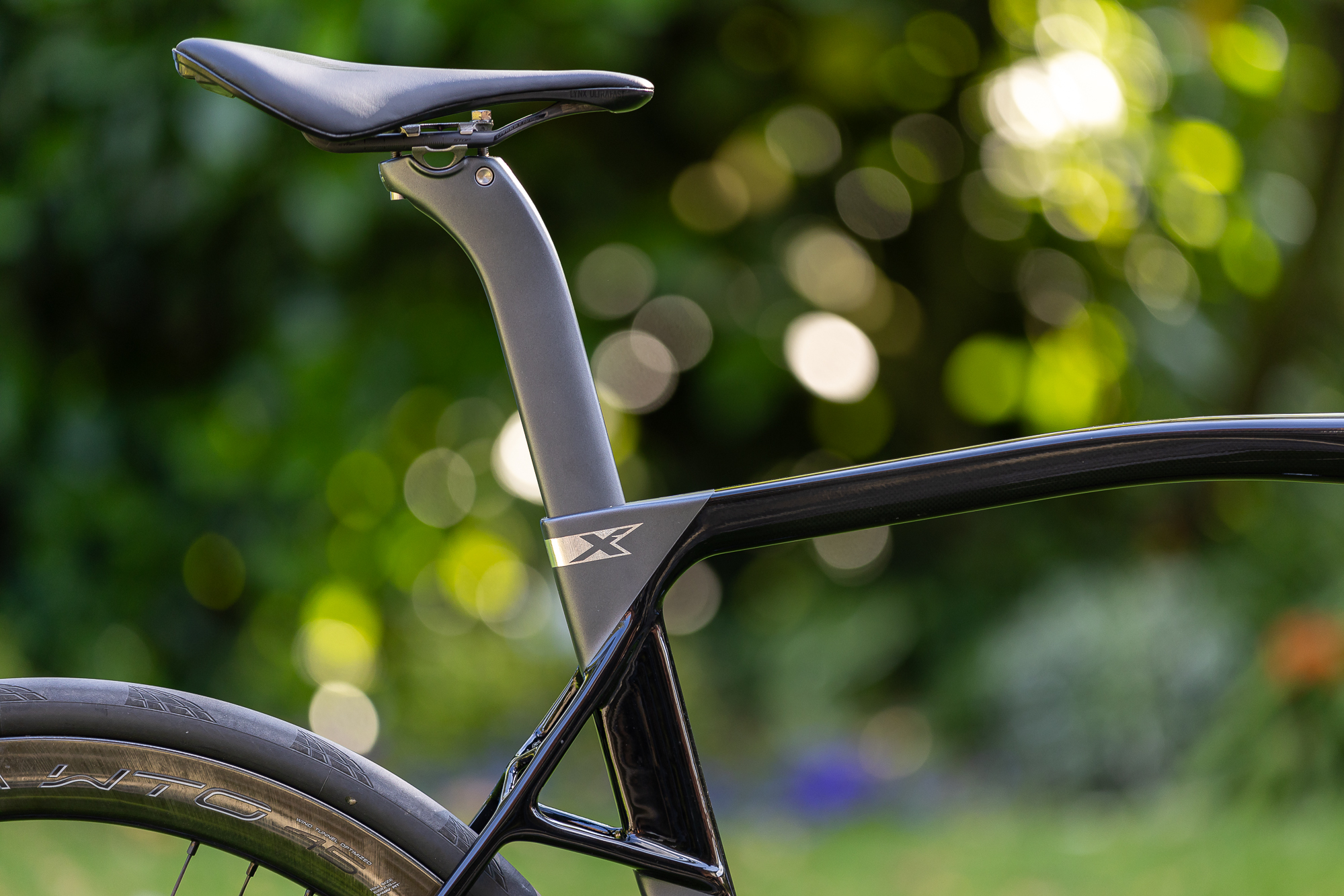
The first few pedal strokes revealed a nicely ‘solid’ feeling ride - no rattles, vibrations or quirks. The bike didn’t feel heavy on the move, but neither did it feel super fast or as frisky as a recently ridden Canyon Aeroad which felt very rewarding but slightly wearisome on poor surfaces. Whether it was the 32mm tyres or the carbon layup and frame design, the Dogma X went about its business in a no-nonsense manner, and Strava revealed pretty decent average speeds too, without me chasing them in any way.
Descending was a particular highpoint, the combination of geometry and wide rubber made it brilliantly assured and confidence-inspiring, and whilst I don’t think anyone is going to suggest it as a quick-witted crit bike, I’d love to descend a long, hairpin-strewn alpine pass on it.
The X also felt very at home holding a steady speed where its aero credentials and low rolling resistance tyres could come to the fore. On group rides, I was very pleasantly surprised at how easy it was to keep up when I feared that it might struggle against racier machines. As a side note, it was nice not to have to worry about line choice quite as much as usual as the large tyres meant that the bike was less troubled by bad roads than those with less voluminous rubber.
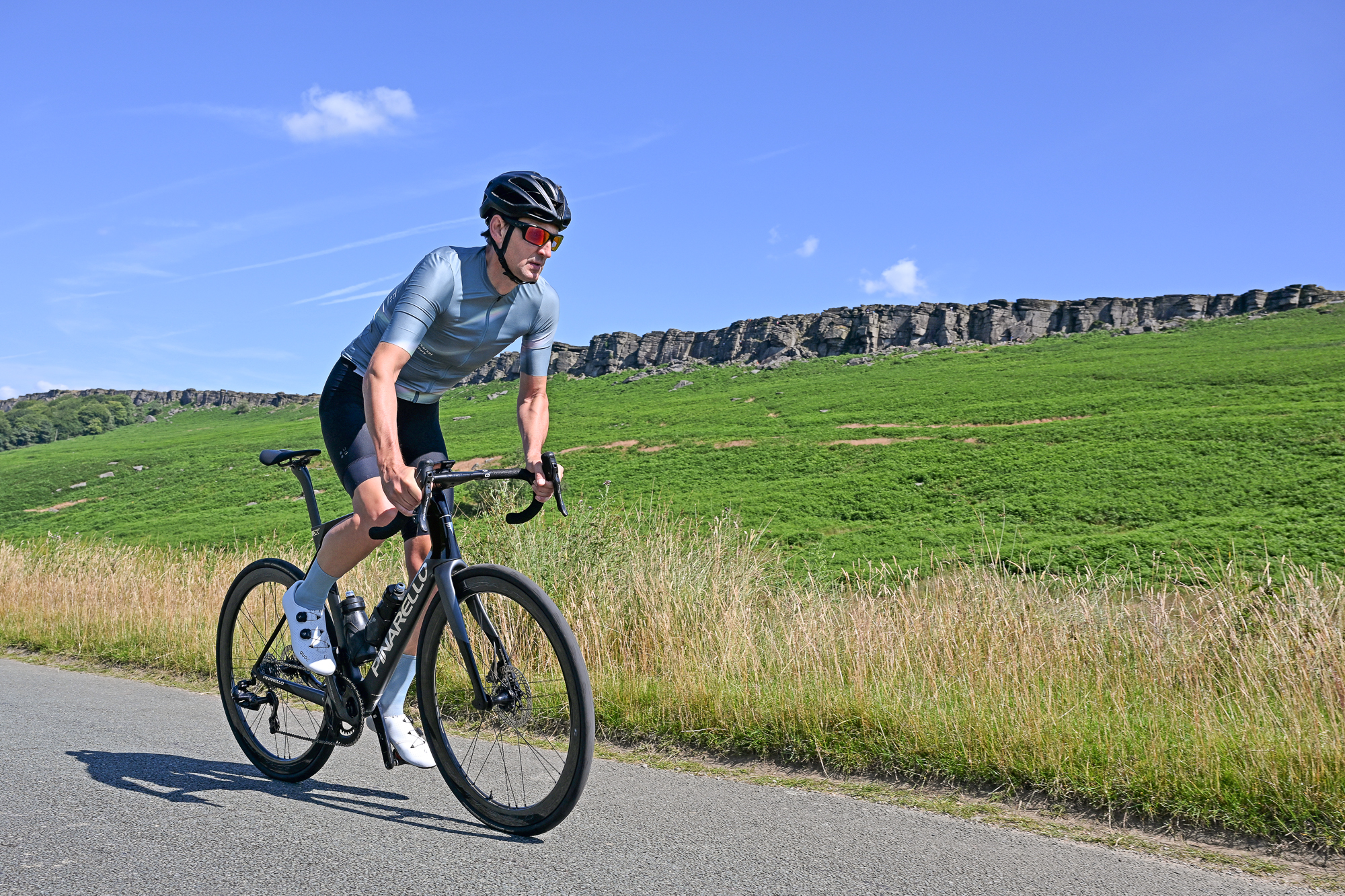
However, the ride wasn’t quite as cossetting as I was expecting, even with 32mm tyres. It wasn’t in any way uncomfortable, but imperfections, vibrations and road noise had their volume turned down rather than being muted entirely. I think in part this was a function of the touchpoints - the Most handlebar, seatpost and saddle are all quite stiff. Clearly, Pirelli’s 35mm rubber would go a long way towards alleviating this, but I think perhaps I was subconsciously expecting Specialized Roubaix levels of compliance when in reality the Dogma X is more of a slightly detuned race bike.
Its one area of potential weakness was acceleration, whether on the flat or up steep hills. Having enjoyed its easy speed elsewhere, I don’t think it responded quite as well to hard efforts, particularly out of the saddle (but then again, neither do I!). Whether this was due to its bottom bracket stiffness as Joe Baker thought, or whether the larger tyres also played a part in its lack of immediacy I’m not sure, but I was more than happy to remain seated and press on the pedals from there instead. This steady input of power really suited the bike and it was easy to keep it up to speed with a nice cadence.

As my time on the bike was coming to an end, I thought I had mostly figured it out - a slightly comfier Dogma F with a leftfield mix of detuned aero frame, race-orientated touchpoints and country lane tyres - giving an adequately muted ride that wouldn’t see you get dropped but also wouldn’t inspire much in the way of extra effort.
And then the curveball - I came home from the final ride, my usual 90km Sunday club run, to see a rather surprising gold medal (not cup!) pop up on Strava indicating a personal best for a segment. Despite hundreds of efforts on different bikes in all possible conditions, the Dogma X had given me my fastest time ever up a 6.5km long hill, beating my 6-year-old previous record set on a hill-orientated Cervelo R5. Not only that, but it had elevated me into the top 2% on a very popular segment.
Hmmm. So a less stiff, less aero, slightly lardy, endurance bike had provided my best time up a hill. Whilst definitely not a scientific test, it would certainly seem that the Dogma X can do more than just ‘keep up’ after all.
Interestingly, the hill in question (Via Gellia near Matlock) is long, fairly shallow and pretty poorly surfaced, which is probably an ideal combination to play to the Dogma X’s strengths and not penalise it for weight or possible lack of out-of-the-saddle stiffness. However, it is also a combination of road characteristics that are extremely common on real-world rides, so perhaps it is better described as a real-world race bike rather than damning it as 'just' an endurance bike.
Value and conclusion
The Dogma X with Shimano Dura-Ace Di2 or SRAM Red costs £13,300, which is a few hundred pounds more than the similarly equipped Dogma F, and no, I don’t know where the extra money goes. The Super Record WRL as I tested doesn’t yet seem to have a UK price, but given that other bikes with WRL as an option cost about £1,000 more than the Dura-Ace version, it’s very likely that as tested, this bike is over £14,000.
That can’t really be considered good value in anyone’s book, but I’m not sure that it matters at this price point. If you have this kind of money to spend on a bike like this then it is quite likely that you are of a certain age, and obviously in a wealthy demographic, and what Pinarello are offering in the Dogma X is a hugely capable, clearly rapid bike that is very understanding of the requirements of normal-but-aspirational riders on everyday roads.
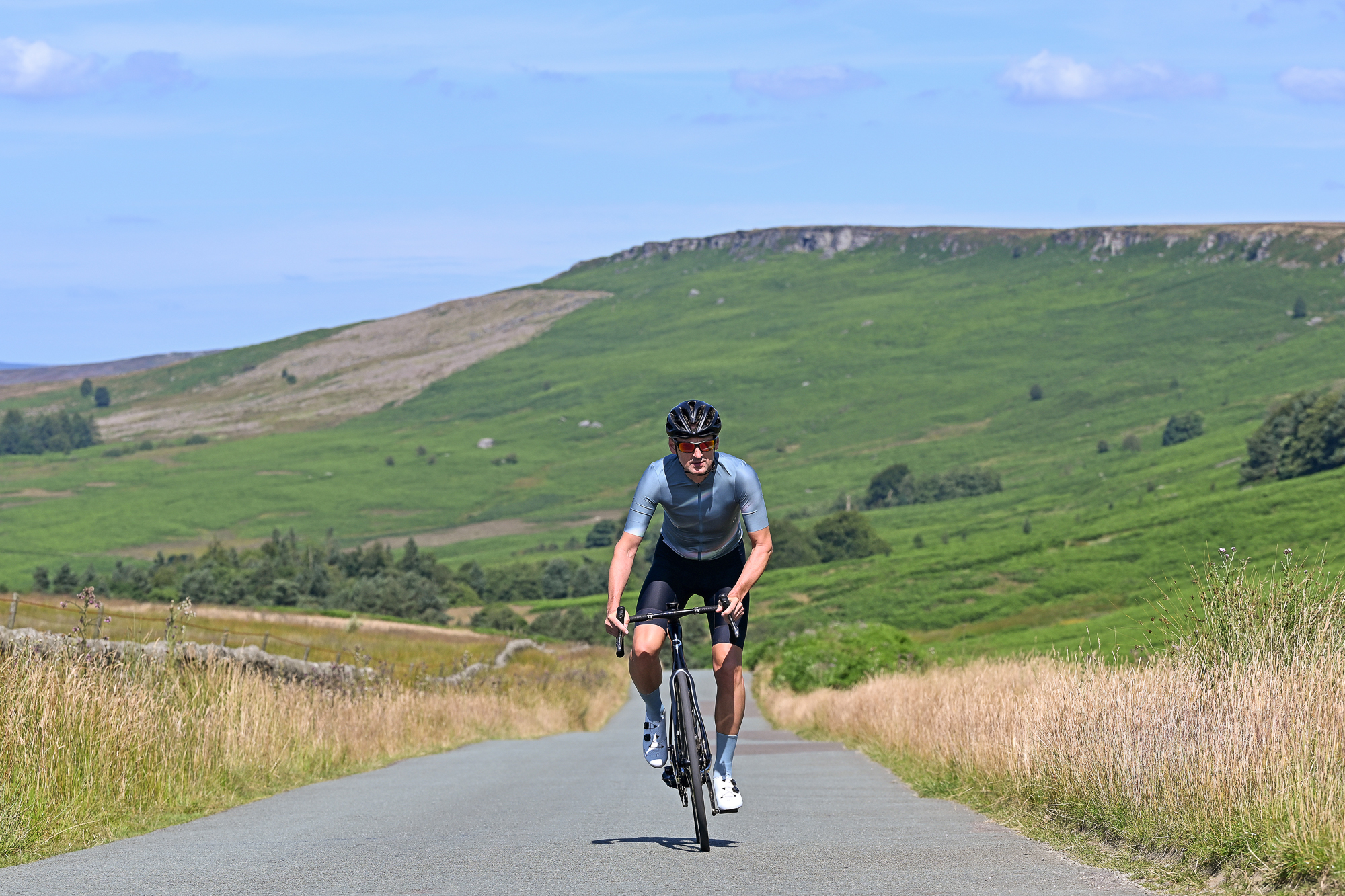
Pinarello says that the X has 95% of the performance of the F, and this seems fair enough, but I’d also suggest that a Dogma F with 32mm tyres (were it possible) and a few steerer spacers would perform very similarly to the Dogma X, doubly so if both bikes could be fitted with the billed 35mm tyres. The X surprised me in many ways and I certainly enjoyed riding it a lot, but it does seem a long way round to get to where it ends up performance-wise.
Slightly more forgiving touchpoints would suit the bike’s intended character a bit better without detracting from its performance, but then again, the specced 35mm tyres would also add more compliance as well. It feels as if Pinarello could have put more clear air between the X and the F with a few simple component changes.
I’m not sure it even has many, if any, direct competitors in this rarefied arena of £13,000+ endurance bikes, but I don’t doubt that the lure of an Italian thoroughbred in a more amenable form with a history-steeped Campagnolo groupset will prove irresistible to some.







